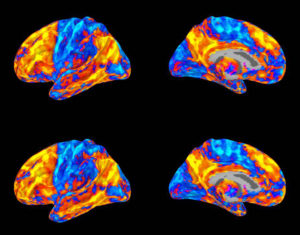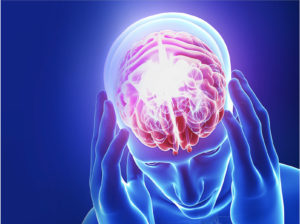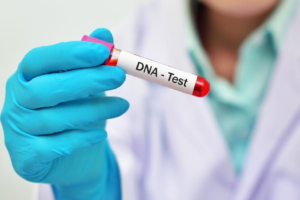Bay Biosciences high quality clinical grade fresh frozen (-80°) serum, plasma, peripheral blood mononuclear cells (PBMC) biofluid samples from unique patients diagnosed from Alzheimer’s Disease. The plasma, sera and PBMC samples were collected from unique Alzheimer’s patients under customized collection protocols provided by the customer for research, development and discovery.

Alzheimer’s Disease Overview
Alzheimer’s disease is a progressive neurological disorder in which the brain cells degenerate and die causing memory loss and cognitive decline. Alzheimer’s disease is the most common cause of dementia, a continuous decline in thinking, behavioral and social skills that disrupts a person’s ability to function independently. Alzheimer’s disease symptoms are mild at first and become more severe over time.
Alzheimer’s disease affects around five million people in the United States, It is the most common type of dementia, accounting for around 80% of cases of dementia in the United States. Estimates suggest that this number will nearly triple to 14 million by 2060. The condition usually affects people aged 65 years and over, with only 10% of cases occurring in people younger than this.
The early signs of the disease may be forgetting recent events or conversations. As the disease progresses, a patient with Alzheimer’s disease will develop severe memory impairment and lose the ability to carry out everyday tasks. Common symptoms of Alzheimer’s disease include memory loss, language problems, and impulsive or unpredictable behavior. As the symptoms worsen, it becomes harder for people to remember recent events, to reason, and to recognize people they know. Eventually, a person with Alzheimer’s disease may need full-time assistance.
One of the main features of the condition is the presence of plaques and tangles in the brain. Another feature is a loss of connection between the nerve cells, or neurons, in the brain. These features mean that information cannot pass easily between different areas of the brain or between the brain and the muscles or organs.
Signs and Symptoms of Alzheimer’s Disease
The symptoms of Alzheimer’s disease progress slowly over several years. The rate at which the symptoms progress is different for each individual. Sometimes these symptoms are confused with other conditions and may initially be put down to old age.
Following are some of the common signs and symptoms of Alzheimer’s disease:
Memory Loss
In the early stages, the main symptom of Alzheimer’s disease is memory lapses. Everyone has occasional memory lapses, but the memory loss associated with Alzheimer’s disease persists and worsens, affecting the ability to function at work or at home. A person may have difficulty taking in new information and remembering information. For example, patients with early Alzheimer’s disease may:
- Forget about recent conversations or events
- Misplace items or losing objects
- Forget the names of places and objects
- Forgetting about appointments or events
- Have trouble thinking of the right word
- Repeating questions or conversation
- Show poor judgement or find it harder to make decisions
- become less flexible and more hesitant to try new things
There are often signs of mood changes, such as increasing anxiety or agitation, or periods of frustration and confusion.
Cognitive Decline
As Alzheimer’s disease develops, memory problems will get worse, it causes difficulty concentrating, reasoning and thinking, especially complex tasks or abstract concepts such as dealing with numbers. Multitasking is especially difficult, and it may be challenging to manage finances, balance checkbooks and pay bills on time. Eventually, a person with Alzheimer’s may be unable to recognize and deal with numbers.
Changes in personality and behavior
Symptoms may also develop, such as:
- Increasing confusion and disorientation, e.g. getting lost, or wandering and not knowing what time of the day it is
- Obsessive, repetitive or impulsive behavior
- Delusions (believing things that are untrue) or feeling paranoid and suspicious about care givers or family members
- Problems with speech or language (aphasia)
- Disturbed sleep
- Changes in mood, such as frequent mood swings, depression and feeling increasingly anxious, frustrated or agitated
- Difficulty performing spatial tasks, such as judging distances
- Seeing or hearing things that other people do not (hallucinations)
- Some people also have some symptoms of vascular dementia
By this stage, someone with Alzheimer’s disease usually needs support to help them with everyday living. For example, they may need help eating, washing, getting dressed and using the toilet.
As the disease progresses In the later stages of Alzheimer’s disease, the patients symptoms become increasingly severe and can be distressing for the person with the condition, as well as their care givers, friends and family. Hallucinations and delusions may come and go over the course of the illness, but can get worse as the condition progresses. Sometimes people with Alzheimer’s disease can be violent, demanding and suspicious of those around them.
A number of other symptoms may also develop as Alzheimer’s disease progresses, such as:
- Problems with eating and swallowing (dysphagia)
- Problem with changing position or moving around without assistance
- Weight loss, sometimes severe
- Unintentional passing of urine (urinary incontinence) or stools (bowel incontinence)
- Gradual loss of speech
- Significant problems with short and long term memory
In the severe stages of Alzheimer’s disease, people may need full-time care and assistance with eating, moving and personal care.

Causes of Alzheimer’s Disease
The exact causes of Alzheimer’s disease aren’t fully understood. But at a basic level, brain proteins fail to function normally, which disrupts the work of brain cells (neurons) and triggers a series of toxic events. Neurons are damaged, lose connections to each other and eventually die. Alzheimer’s disease is thought to be caused by the abnormal build-up of proteins in and around brain cells. One of the proteins involved is called amyloid, deposits of which form plaques around brain cells. The other protein is called tau, deposits of which form tangles within brain cells. Although it’s not known exactly what causes this process to begin, scientists now know that it begins many years before symptoms appear.
As brain cells become affected, there’s also a decrease in chemical messengers called neurotransmitters involved in sending messages, or signals, between brain cells. Levels of one neurotransmitters known as acetylcholine are particularly low in the brains of people with Alzheimer’s disease. Over time, different areas of the brain shrink. The first areas in the brain usually affected are responsible for memory. In more unusual forms of Alzheimer’s disease, different areas of the brain are affected. The first symptoms may be problems with vision or language rather than memory.
Scientists believe that for most patients, Alzheimer’s disease is caused by a combination of genetic, lifestyle and environmental factors that affect the brain over time. Less than 1% of the time, Alzheimer’s is caused by specific genetic changes that virtually guarantee a person will develop the disease. These rare occurrences usually result in disease onset in middle age.
The damage most often starts in the region of the brain that controls memory, but the process begins years before the first symptoms. The loss of neurons spreads in a somewhat predictable pattern to other regions of the brains. By the late stage of the disease, the brain has shrunk significantly.
Researchers trying to understand the cause of Alzheimer’s disease are focused on the role of two proteins:
- Plaques. Beta-amyloid is a fragment of a larger protein. When these fragments cluster together, they appear to have a toxic effect on neurons and to disrupt cell-to-cell communication. These clusters form larger deposits called amyloid plaques, which also include other cellular debris.
- Tangles. Tau proteins play a part in a neuron’s internal support and transport system to carry nutrients and other essential materials. In Alzheimer’s disease, tau proteins change shape and organize themselves into structures called neurofibrillary tangles. The tangles disrupt the transport system and are toxic to cells.
Risk Factors of Alzheimer’s Disease
Although it is unknown what triggers Alzheimer’s disease, several factors are known to increase your risk of developing the condition. Following are some ok the known factors which increase the risk of developing Alzheimer’s disease:
- Age: Increasing age is the greatest known risk factor for Alzheimer’s disease. Alzheimer’s is not a part of normal aging, but as you grow older the likelihood of developing Alzheimer’s disease increases. The likelihood of developing Alzheimer’s disease doubles every 5 years after you reach 65.
- Family History: The risk of developing Alzheimer’s is somewhat higher if a first-degree relative, either a parent or a sibling has the disease, your chances of getting Alzheimer’s disease becomes high.
- Genetics: A variation of the apolipoprotein E gene APOE ε4 is called a risk-factor gene because it increases a person’s risk of developing Alzheimer’s disease. About 30 percent of people carry one copy of APOE ε4 and 2 to 3 percent carry two copies but not everyone with this variation of the gene develops the disease. Amyloid precursor protein (APP) on chromosome 21, Presenilin 1 (PSEN1) on chromosome 14, Presenilin 2 (PSEN2) on chromosome 1 are the three single-gene mutations associated with early-onset Alzheimer’s disease, but early onset of Alzheimer’s disease is rare, representing less than 10 percent of all Alzheimer’s patients.
- Down Syndrome: Patients with Down’s syndrome are at a higher risk of developing Alzheimer’s disease. This is because the genetic fault that causes Down’s syndrome can also cause amyloid plaques to build up in the brain over time, which can lead to Alzheimer’s disease in some people. This is likely related to having three copies of chromosome 21 and subsequently three copies of the gene for the protein that leads to the creation of beta-amyloid.
- Head Trauma: Patients who have had some kind of a severe head trauma have a greater risk of Alzheimer’s disease. Several studies found that in people age 50 years or older who had a traumatic brain injury (TBI), the risk of dementia and Alzheimer’s disease increased.
- Cardiovascular Disease: Research has shown that the same risk factors associated with heart disease may also increase the risk of Alzheimer’s disease. These include:
- Lack of Exercise
- Smoking or exposure to secondhand smoke
- High Blood Pressure (Hypertension)
- Obesity
- Diabetes
- High Cholesterol
- Excess Alcohol Drinking
Other factors that increase the risk of Alzheimer’s disease include severe or repeated traumatic brain injuries and having exposure to some environmental contaminants, such as toxic metals, pesticides, and industrial chemicals.

Detailed clinical data and pathology annotations including patient’s corresponding diagnostic test values, MMSE score, MRI data are provided to a valued pharmaceutical customer for research and discovery.
Bay Biosciences is a global leader in providing researchers with high quality, clinical grade, fully characterized human tissue samples, bio-specimens and human bio-fluid collections from cancer (tumor) tissue, cancer–serum, cancer–plasma cancer-PBMC and human tissue samples from most other therapeutic areas and diseases.
Bay Biosciences maintains and manages it’s own bio-repository, human tissue bank (biobank) consisting of thousands of diseased samples (specimens) and from normal healthy donors available in all formats and types. Our biobank procures and stores fully consented, deidentified and institutional review boards (IRB) approved human tissue samples and matched controls.
All our human human tissue collections, human specimens and human bio-fluids are provided with detailed samples associated patient’s clinical data. This critical patient’s clinical data includes information relating to their past and current disease, treatment history, lifestyle choices, biomarkers and genetic information. Patient’s data is extremely valuable for researchers and is used to help identify new effective treatments (drug discovery & development) in oncology, other therapeutic areas and diseases. This clinical information is critical to demonstrate their impact, monitor the safety of medicines, testing & diagnostics, and generate new knowledge about the causes of disease and illness.
Bay Biosciences banks wide variety of human tissue samples and biological samples including cryogenically preserved -80°C, fresh, fresh frozen tissue samples, tumor tissue samples, FFPE’s, tissue slides, with matching human bio-fluids, whole blood and blood derived products such as serum, plasma and PBMC’s.
Bay Biosciences is a global leader in collecting and providing human tissue samples according to the researchers specified requirements and customized, tailor made collection protocols. Please contact us anytime to discuss your special research projects and customized human tissue sample requirements.
Bay Biosciences provides human tissue samples (human specimens) from diseased and normal healthy donors; including peripheral whole-blood, amniotic fluid, bronchoalveolar lavage fluid (BAL), sputum, pleural effusion, cerebrospinal fluid (CSF), serum (sera), plasma, peripheral blood mononuclear cells (PBMC’s), saliva, Buffy coat, urine, stool samples, aqueous humor, vitreous humor, kidney stones, renal calculi, nephrolithiasis, urolithiasis and other bodily fluids from most diseases including cancer. We can also procure most human bio-specimens and can do special collections and requests of human samples that are difficult to find. All our human tissue samples are procured through IRB approved clinical protocols and procedures.
In addition to the standard processing protocols Bay Biosciences can also provide human plasma, serum, PBMC bio-fluid samples using custom processing protocols, you can buy donor specific sample collections in higher volumes and specified sample aliquoting from us. Bay Biosciences also provides human samples from normal healthy donors, volunteers, for controls and clinical research, contact us Now.
日本のお客様は、ベイバイオサイエンスジャパンBay Biosciences Japanまたはhttp://baybiosciences-jp.com/contact/までご連絡ください。
